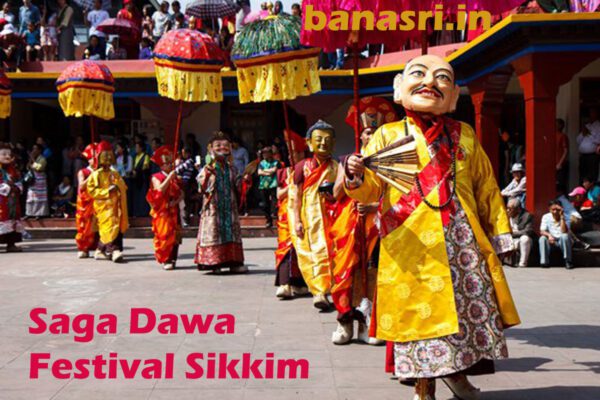
Saga Dawa Festival, Sikkim: Commemorating the Life of Lord Buddha
Introduction
The Saga Dawa Festival is a sacred Buddhist festival observed with great reverence in Sikkim, India. It marks the triple events of Lord Buddha’s birth, enlightenment (nirvana), and death (parinirvana). Celebrated by Buddhists across the world, the festival holds special significance in Sikkim due to its deep-rooted Buddhist heritage and the presence of numerous monasteries.
Timing of the Festival
- When: The Saga Dawa Festival is celebrated annually on the full moon day of the fourth lunar month of the Tibetan calendar, which usually falls in May or June.
- Significance: It commemorates the major events in the life of Lord Buddha, including his birth, enlightenment, and death, all believed to have occurred on the same day.
Locality of the Festival
- Where: The festival is prominently celebrated at various Buddhist monasteries and stupas across Sikkim, particularly in places like Gangtok, Rumtek, and Pelling.
- Importance: Sikkim’s monasteries, including Rumtek Monastery (Ranka Monastery), serve as focal points for religious ceremonies and rituals during the Saga Dawa Festival.
Nature of the Festival
- Type: Saga Dawa is primarily a religious and cultural festival deeply rooted in Buddhist traditions.
- Essence: The festival emphasizes the virtues of compassion, mindfulness, and spiritual awakening, reflecting the teachings and life of Lord Buddha.
Highlights of the Saga Dawa Festival
Prayers and Religious Rituals
- Offering of Butter Lamps:
- Ritual: Buddhists offer butter lamps at monasteries and stupas to symbolize the dispelling of ignorance and the spread of wisdom.
- Significance: Lighting butter lamps is believed to bring merit and purify negative karma.
- Specialty: Monasteries are adorned with thousands of butter lamps during the festival, creating a mesmerizing sight.
- Prayer Flags:
- Tradition: Colorful prayer flags, known as “lungta,” are hung in homes, monasteries, and on mountain passes.
- Purpose: It is believed that the prayers and mantras inscribed on the flags are carried by the wind, spreading blessings and positive energy.
- Specialty: The fluttering of prayer flags during Saga Dawa symbolizes the spread of compassion and goodwill.
Circumambulation of Holy Sites
- Kora or Parikrama:
- Practice: Devotees perform circumambulation (kora) around sacred sites such as monasteries, stupas, and mountains.
- Significance: Kora is a form of spiritual practice that purifies negative karma and accumulates merit.
- Specialty: The circumambulation of prominent sites like the Boudhanath Stupa in Gangtok and the Khecheopalri Lake is a key feature of the festival.
Alms Giving and Charity
- Giving of Alms:
- Custom: Buddhists engage in acts of charity and generosity, offering alms to monks, the needy, and the less fortunate.
- Importance: Giving alms is considered a virtuous practice that cultivates compassion and selflessness.
- Specialty: During Saga Dawa, people actively participate in charitable activities, contributing to the welfare of the community.
Cultural Performances and Events
- Cham Dances:
- Performance: Monks perform traditional masked dances, known as Cham dances, depicting religious stories and legends.
- Significance: Cham dances are believed to ward off evil spirits and bring blessings to the audience.
- Specialty: The intricate costumes, masks, and rhythmic movements make Cham dances a captivating spectacle during the festival.
- Buddhist Teachings (Dharma Talks):
- Discourses: Monks and spiritual teachers deliver teachings on Buddhist philosophy, ethics, and meditation.
- Purpose: These discourses educate and inspire devotees to deepen their understanding of the Dharma (Buddhist teachings).
- Specialty: Dharma talks during Saga Dawa provide spiritual guidance and encourage personal reflection and growth.
Specialty of Saga Dawa Festival
- Spiritual Significance: Saga Dawa Festival holds profound spiritual significance, commemorating the life and teachings of Lord Buddha.
- Cultural Richness: The festival showcases Sikkim’s rich Buddhist heritage through rituals, prayers, and cultural performances.
- Community Participation: It fosters a sense of community and unity among Buddhists, who come together to practice rituals, offer prayers, and engage in charitable activities.
- Tourist Appeal: Saga Dawa Festival attracts tourists and visitors interested in experiencing Buddhist traditions, cultural festivities, and the serene beauty of Sikkim.
Conclusion
The Saga Dawa Festival in Sikkim is a sacred occasion that honors the life and teachings of Lord Buddha, emphasizing compassion, wisdom, and spiritual awakening. Celebrated with fervor and devotion at monasteries and sacred sites across Sikkim, the festival brings together Buddhists from various backgrounds to engage in prayers, rituals, and cultural activities. Through its emphasis on generosity, mindfulness, and the pursuit of spiritual enlightenment, Saga Dawa Festival remains a cherished event that embodies the essence of Buddhism in the picturesque landscapes of Sikkim.

I’m extremely impressed along with your writing talents
and also with the format in your blog. Is this
a paid subject or did you modify it your self? Either way keep up the nice high
quality writing, it is uncommon to look a nice weblog like this one these days.
Youtube Algorithm!
I am really impressed together with your writing
abilities as neatly as with the layout on your weblog.
Is this a paid subject matter or did you modify it yourself?
Either way keep up the excellent quality writing, it’s uncommon to peer a
nice blog like this one nowadays. TikTok ManyChat!